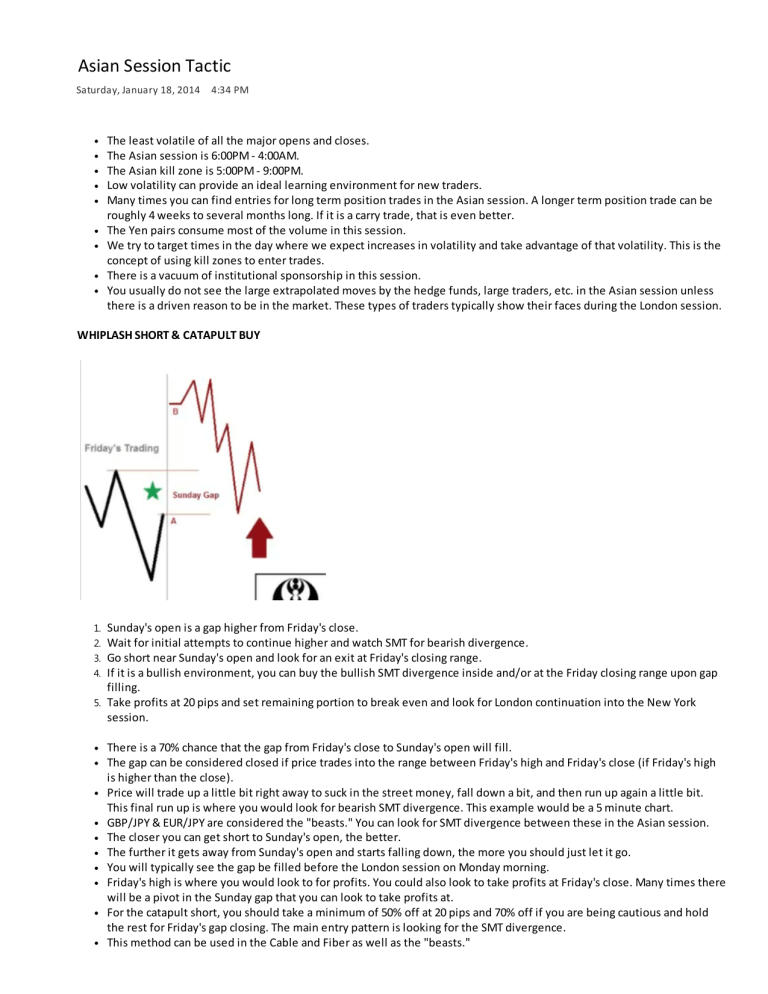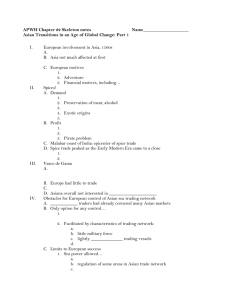
Asian Session Tactic Saturday, January 18, 2014 4:34 PM The least volatile of all the major opens and closes. The Asian session is 6:00PM - 4:00AM. The Asian kill zone is 5:00PM - 9:00PM. Low volatility can provide an ideal learning environment for new traders. Many times you can find entries for long term position trades in the Asian session. A longer term position trade can be roughly 4 weeks to several months long. If it is a carry trade, that is even better. The Yen pairs consume most of the volume in this session. We try to target times in the day where we expect increases in volatility and take advantage of that volatility. This is the concept of using kill zones to enter trades. There is a vacuum of institutional sponsorship in this session. You usually do not see the large extrapolated moves by the hedge funds, large traders, etc. in the Asian session unless there is a driven reason to be in the market. These types of traders typically show their faces during the London session. WHIPLASH SHORT & CATAPULT BUY 1. 2. 3. 4. 5. Sunday's open is a gap higher from Friday's close. Wait for initial attempts to continue higher and watch SMT for bearish divergence. Go short near Sunday's open and look for an exit at Friday's closing range. If it is a bullish environment, you can buy the bullish SMT divergence inside and/or at the Friday closing range upon gap filling. Take profits at 20 pips and set remaining portion to break even and look for London continuation into the New York session. There is a 70% chance that the gap from Friday's close to Sunday's open will fill. The gap can be considered closed if price trades into the range between Friday's high and Friday's close (if Friday's high is higher than the close). Price will trade up a little bit right away to suck in the street money, fall down a bit, and then run up again a little bit. This final run up is where you would look for bearish SMT divergence. This example would be a 5 minute chart. GBP/JPY & EUR/JPY are considered the "beasts." You can look for SMT divergence between these in the Asian session. The closer you can get short to Sunday's open, the better. The further it gets away from Sunday's open and starts falling down, the more you should just let it go. You will typically see the gap be filled before the London session on Monday morning. Friday's high is where you would look to for profits. You could also look to take profits at Friday's close. Many times there will be a pivot in the Sunday gap that you can look to take profits at. For the catapult short, you should take a minimum of 50% off at 20 pips and 70% off if you are being cautious and hold the rest for Friday's gap closing. The main entry pattern is looking for the SMT divergence. This method can be used in the Cable and Fiber as well as the "beasts." Don't risk any more than 1% on a Sunday gap trade because they are tricky. The catapult buy trade should be used in bullish daily environments and market flow and market structure is implying higher prices. Price could be trading at a key support level with market flow being up. We could be trading off a short term low on the daily chart, etc. Inside the Sunday gap, you want to look for bullish SMT divergence at the lows. The GBP/JPY & EUR/JPY are good for the Asian session. For both of these 2 trades you want to take some profits at 20 pips. One of the surest signs of maturity and control in trading is understanding your personality make up and your personal market comfort zone. Trading outside this comfort zone makes trading very difficult. Don't risk a lot on Sunday trading. Reverse the above concepts for a whiplash buy & catapult short trade: "The early bird may get the worm, but the second mouse gets the cheese." Quote based on waiting for the second attempt lower on a whiplash buy trade. The surest way to cover the spread more quickly and have trades enter into profits the quickest is to enter into the market when price is going against your anticipated trade direction. This pattern is basically trading a turtle soup entry. The Asian session is typically very lazy in terms of breaking to new levels. It is unwilling to make new lows and continue on lower unless it is news event driven. The Asian session is not a session that produces large extrapolated moves, but sometimes it can get you into a nice position trade. ASIAN SESSION BUY Typically the Asian session will trade counter to the New York session direction. Even in bear trending market environments the Asian session will "engineer" a rally that many times provides the swing setup for London open trading. 1. The Asian session rarely sees follow through on new lows (turtle soup). This is a very important characteristic of the 2. 3. 4. Asian session. On higher time frames like the weekly, daily, 4 hour, and/or 60 minute charts, note key S/R levels. Anticipate OTE buys to form in the Asian session when price trades down into support. Take profits at OTE levels from the New York swing and leave a portion on for a continuation into the London session. The Asian session bounce into a larger OTE is a tradable pattern. You are not looking for home runs with this trade. At a minimum, you want price to bounce at least 20 pips off the key support level. Once it has done that you can draw your Fibs and look for an OTE. The nature of price not getting back to that key support level (and only an OTE), is what makes it a failure swing. Anticipate the likelihood of the Asian session trading being the "engineered" rally setting up for the London open short. There could be a low that price is reaching for to gun stops and that would be a turtle soup entry into the trade. This is the aggressive entry in this trade setup. The cautious move would be waiting for the OTE to form. If it blows through the 79% retracement and retests the actual support level is it still a valid optimal trade entry? Absolutely, because you will have your stop 10 pips below the low that it forms. We are trading counter trend the previous New York session regardless of what the long term bias it, but it is absolutely stellar and consistent when traded with the long term bias. Trust and anticipate your support & resistance levels. Learn to anticipate the Asian session buy when price trades down into a support level at this time. Don't just buy it and hold onto it and wait 5 days. Be mindful of the higher time frame bias and the potential of the rally being suspect, an engineered rally into a bearish OTE signal. Obviously, reverse the concepts above for an Asian session sell signal: The majority of your time should not be spent studying charts on a 60 minute chart or less. Your chart study should be on the 4 hour charts and higher with the leg work being done on the lower time frame charts. Look at the weekly chart once before the week and once in the middle of the week. This pattern can unfold around the highest high in the last 3 days for the Asian session sell.




